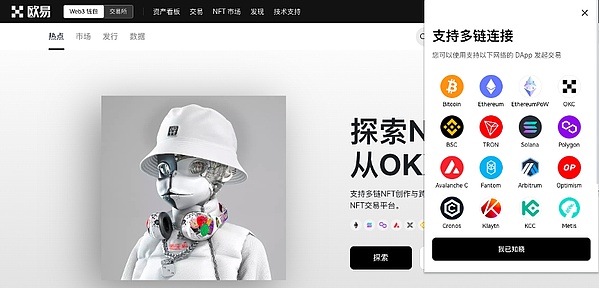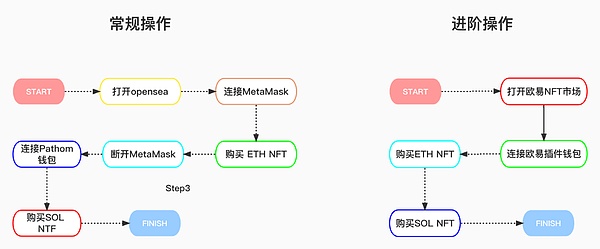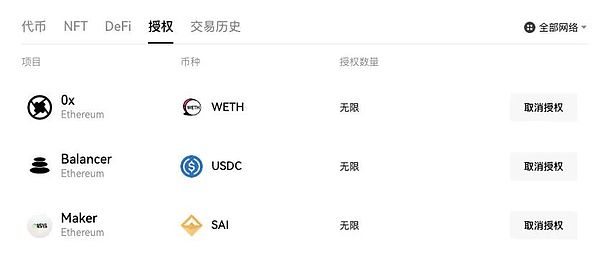Introduction
The future of Web3 must be multi-chain, the next cycle of the narrative, but also around the chain of high-quality applications built up a multi-chain ecology.
At present, the development of multi-chain is still in its early stage. If we want to break through each ecological island and realize the mutual exchange of assets, the key can not be separated from the basic infrastructure-the support of wallet-to realize multi-chain aggregation.
From the current situation of the industry, the vast majority of wallets only achieve multi-chain 1.0, that is, in the wallet App side to support heterogeneous multi-chain, but 80% of the Web3 use of the scene is in the plug-in side, often need to cut chain and switch wallets, sets the threshold for the user to interact with the WEB3 scenario, increasing the burden.
There is no such wallet, users only need to click on the link wallet plug-in, can interact with different blockchain ecology, and all ecological Token assets are displayed in a page, more clear and intuitive, avoid omissions.
- Is there a future for web 3.0 games?
- Why is blockchain the gateway to Web3?
- From concept to landing Web3.0 takes shape
As some KOL said, “As a WEB3 expert, hard chain cut wallet for a long time, recently found a new WEB3 wallet, easy to use, cross-chain price is good, a whole love to live”.
Let’s keep it a secret here. I have found the wallet that he mentioned. I will share it with you at the end of this article.
The development of WEB3 chain from the perspective of globalization
In the past few years, there has been a debate on the application of blockchain in the encryption market. At that time, many points of view that ether square a blockchain can meet all the needs of the market, the other blockchain is pseudo-demand. But the availability of blockchain has become less controversial with the rise of diverse playstyles such as DeFi Summer and NFT.
Nowadays, the situation of multi-chain parallel development has become an established fact in the cryptographic world. More and more builders are devoting themselves to the construction of high-efficiency blockchain protocols, such as Aptos, Sui and so on. From the perspective of globalization, it is easier to understand and conclude that the future of Web3 must be multi-chain development.
Taking economic globalization as an example, there are great differences in productivity and production level among countries, which need international cooperation and division of Labor. Among them, the Southeast Asian market has a more abundant labor supply and much lower manufacturing costs, while the European and n markets have higher technology levels and higher labor costs, both of which have their own unique advantages, while ultimately creating two distinct markets, it also drives the global economy.
Similarly, different blockchains have their own comparative advantages for different application scenarios. For example, Ethereum is the most ecologically prosperous, but GAS is relatively high, so it is not suitable for GameFi’s high-frequency interaction, so there are new chains such as OKX public chain, Robin, Immutable X and so on that focus on high-performance and low-GAS; for example, dapper Labs gained the attention of the mainstream market with NBA Top Shot. The Flow public chain, which was built by Dapper Labs, also became the special public chain for the mainstream brands to enter the NFT market.
Therefore, it is conceivable that the multi-chain world of the future will be increasingly specialized and biased. Specialized blockchains are more valuable because they attract developers and users who need them based on their specific use cases, creating their network effects. When you think of Silicon Valley, you think of the high-tech industry. This global division of Labor also applies to the Web 3 world.
“It’s a reasonable guess that the narrative for the next big cycle is a multi-chain ecosystem built around high-quality applications on each chain. “Building a public chain to meet all needs” may be a thing of the past. After all, we really don’t need to do everything in one chain, and expect more application chains to emerge in the future. Well-known investor A16z is confident about the future of multi-chain ecology.
Multi-chain ecological prosperity can not be achieved without the support of wallets and facilities
Of course, Web3 is still in the early stages of multi-chain development, problems continue.
Data shows that the number of WEB3 blockchain more than 100, each blockchain has its own native tokens and different standards of tokens project. The real pain point of the market is that there are high barriers in the circulation of various kinds of cryptographic assets, which hinder the free flow of assets and the interaction of blockchains, thus hindering the development of WEB3 in depth, the core is to open up each ecological island, realize the asset interconnection between each block chain.
By comparing the global perspective of international trade, may be able to give us a solution to the problem.
At present, there are more than 200 sovereign states on the Earth, with hundreds of different legal tender systems, but this has not affected international trade. Behind International Trade, international payment systems such as Visa and SWIFT play an irreplaceable role. When we need to pay in different currencies in global trade, we can do multi-currency clearing directly through these payment platforms, rather than manually switching between national bank cards.
Back at Web 3, we’re in a world of multi-chained parallelism, where all kinds of DAPP interactions and payments depend on the underlying infrastructure-the wallet. Only the implementation of multi-chain wallet polymerization, to meet the growing demand for multi-chain interaction.
However, at present, most wallets only achieve multi-chain 1.0, that is, in the wallet App side support heterogeneous multi-chain, and 80% of the WEB3 use of the scene is in the plug-in side, the market demand is difficult to be effectively met.
For example, for the MetaMask and other plug-in wallets, the implementation of a multi-chain transaction scenario requires cumbersome chain cutting operations, and the need to manually add network information when encountering a new blockchain network, the related node information also needs to be added in a dedicated browser, which is tedious and complicated; in addition, MetaMask does not support SOL concatenation, so the user needs to replace it with a Phantom wallet. All of this sets the bar for users to interact with WEB3 scenarios, increasing the burden.
Therefore, the ultimate goal of the wallet track next step, should be to achieve multi-chain polymerization, no sense cut chain.
The recently upgraded ouyi WEB3 plug-in wallet effectively solves the above problems. Users only need to click on the connect wallet plug-in to interact with different public chain ecology, and all the ecological Token assets are displayed in a page, more clear and intuitive, to avoid missing. Ouyi Web3 plug-in wallet came out, the real realization of plug-in-end cross-eco-cut chain, push the wallet into the multi-chain 2.0.

OUI plug-in wallet to achieve Web3 senseless chain
On October 11th, Lennix Lai, director of financial markets at OKX, tweeted about the newly upgraded OUI Web3 plug-in wallet.
“I am pleased to announce that the OKX add-on wallet has been launched with cross-eco senseless chain functionality. Users can connect to multi-chain DAPP using the OUI WEB3 wallet plug-in, and can freely use the DAPP function between EVM and Sol ecology without chain cutting or switching wallets. I’m happy to say that this is unprecedented, the first of its kind.”
For example, let’s say we’re interested in aether and Solana’s NFT in the OIE NFT market. In the past, we had to switch two wallets, one for each account, which was time-consuming and labor-intensive. Now, with the OIE add-on wallet, with just one click, you can buy NFT directly in two ecologies, easy to use, convenient and quick.

How many steps does it take to purchase an ETH NFT and an SOL NFT?
At its core, the wallet integrates dozens of mainstream public chains, including Ethereum and Solana, connecting EVM and Sol ecology without users having to manually add network information. According to the official disclosure, the following will be integrated Aptos, Cosmos and other isomeric ecology. In other words, in the future, an easy-to-use plug-in wallet will be able to interact with the entire WEB3 DAPP.
In recent days, Aptos main network token APT airdrop in the encryption market caused widespread concern. Other projects in the Aptos ecosystem, on the other hand, have not yet been announced for air-dropping, which has also stirred up a number of Luftwaffe groups. However, wallets such as Metamask do not currently support the Aptos public chain, and users need to download dedicated wallets, which undoubtedly increases the barriers to interaction. Now that the OUI WEB3 wallet is supporting Aptos, it’s an opening for the Maoists.
Finally, several use cases of the OUI plug-in wallet are introduced. Users can go to the official website and click on the“Connect wallet” to connect to the OUI plugin wallet; click on the“Discover” button to view all of the current Web3 quality projects; and click on the project name directly to interact with it, it saves you the hassle of searching the web, and it also saves you from being scammed by fake projects, as follows:

In addition, users can also click on the“Asset Kanban” function, tracking their different agreements on a number of different public chain on all asset portfolios, includes tokens, DeFi mining proceeds, NFT collectibles, licensing, and trading history. At a glance, you no longer have to constantly switch between multiple applications. In particular, the“Authorized” view can be used to help reduce account risk, as follows:

No matter how good a product is, it still needs to go through market inspection. Ouyi Web3 plug-in wallet launched, but also received a lot of praise encryption players.
- “As a WEB3 expert, I’ve been slaving away to cut my wallet for a long time. Recently, I used my oui Web3 wallet, which is easy to use and has a good cross-link price. I love it,” tweeted Kevin.
- “Recently, I tried the OEI Web 3 Wallet for $XEN. The non-cutting chain is very smooth, the plug-in end integrates ETH and Sol, and it really works!” Said Twitter user@waxingxin.
- ……
Despite the positive market reaction, this is not the end of the OUI plug-in wallet. Lennix Lai also says there is a long way to go. “The future of Web3 will be a multi-linked and prosperous world, and we hope that our products will help make it more convenient and secure for users to seamlessly link to the multi-linked world of Web3.”
The The World Is Flat, open web 3 world is flat. Some day in the future, users may forget the concept of chain. We’re also looking forward to more products that take users through the seamlessly linked Web 3 world.
Like what you're reading? Subscribe to our top stories.
We will continue to update Gambling Chain; if you have any questions or suggestions, please contact us!